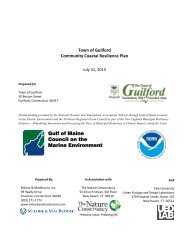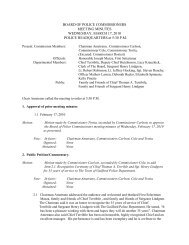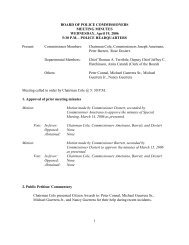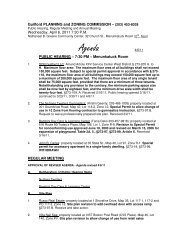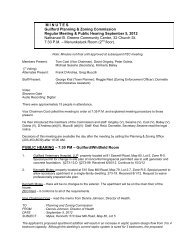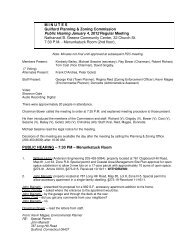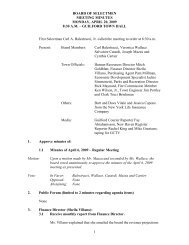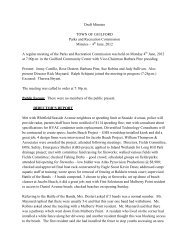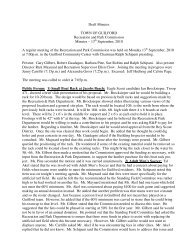Natural Resource Inventory and Assessment - Town of Guilford
Natural Resource Inventory and Assessment - Town of Guilford
Natural Resource Inventory and Assessment - Town of Guilford
You also want an ePaper? Increase the reach of your titles
YUMPU automatically turns print PDFs into web optimized ePapers that Google loves.
evaluation <strong>of</strong> current designated areas <strong>of</strong> septic systems in <strong>Guilford</strong>. In developed areas, lakes, which are<br />
surface expressions <strong>of</strong> ground water, are also susceptible to contamination. Swimming at Lake Quonnipaug<br />
is periodically closed due to unacceptably high bacterial levels.<br />
Sources <strong>of</strong> stress: faulty septic systems, l<strong>and</strong>scape fertilizers, pesticides, herbicides, leachate from waste<br />
sites <strong>and</strong> contaminated wastewater discharge sites (See Map C-4), oil spills, road salt, heavy metals from<br />
motor vehicles, household chemicals, hormones <strong>and</strong> pharmaceuticals, atmospheric deposition from car<br />
exhaust <strong>and</strong> coal-fired power plants.<br />
Altered sedimentation: Sediments are the primary contaminant found in stormwater run<strong>of</strong>f,<br />
particularly in watersheds where development occurs on steep slopes. Construction activities can double<br />
the pre-construction sediment loss <strong>of</strong> a site. Eroded soils transported to rivers are deposited on stream<br />
bottoms, reducing habitat diversity (e.g., pools <strong>and</strong> riffles) <strong>and</strong> eliminating spawning areas <strong>and</strong> shelter used<br />
by aquatic life. Suspended sediment also injures <strong>and</strong> clogs gills <strong>of</strong> fish <strong>and</strong> sensitive invertebrates.<br />
According to the Marina Commission, excess silt in the West River is creating the need for more frequent<br />
dredging <strong>of</strong> <strong>Guilford</strong> Harbor. In lakes <strong>and</strong> ponds murky water reduces light penetration <strong>and</strong> can kill<br />
aquatic plants, interfere with feeding <strong>of</strong> vision-dependent fishes, <strong>and</strong> smother fish eggs.<br />
Sources <strong>of</strong> stress: stormwater run<strong>of</strong>f from development <strong>and</strong> associated construction, road s<strong>and</strong>ing,<br />
removal <strong>of</strong> riparian vegetation<br />
Loss <strong>of</strong> habitat: Freshwater systems are embedded within, <strong>and</strong> greatly influenced by, surrounding<br />
upl<strong>and</strong>s. (See Section D.) Many animal species, particularly amphibians <strong>and</strong> some reptiles, require these<br />
upl<strong>and</strong>s to complete their life cycles. Habitat loss therefore encompasses clearing or alteration <strong>of</strong> nearby<br />
upl<strong>and</strong>s, as well as outright removal or alteration <strong>of</strong> aquatic <strong>and</strong> wetl<strong>and</strong> systems themselves.<br />
Sources <strong>of</strong> stress: incompatible development<br />
Altered hydrology (water movement <strong>and</strong> storage): The hydrologic regime is the primary driver <strong>of</strong> river<br />
systems. As impervious surface increases or vegetation is eliminated, the amount <strong>of</strong> water that infiltrates<br />
into the soil decreases, <strong>and</strong> stormwater moves through a watershed <strong>and</strong> into a freshwater body more rapidly.<br />
This increased surface flow, coupled with traditional methods <strong>of</strong> stormwater management, result in altered<br />
timing, duration, frequency, <strong>and</strong> magnitude <strong>of</strong> flood flows in rivers. The increased volume <strong>of</strong> water results<br />
in unstable banks, channel widening, <strong>and</strong> channel bed lowering, promoting further flooding. Many<br />
engineered structures are created to retain <strong>and</strong> delay delivery in order to mitigate flood impacts. This can<br />
lead to the reduction <strong>of</strong> peak flows, water fluctuations, <strong>and</strong> periodic over-bank flooding, all necessary to<br />
maintain instream <strong>and</strong> riparian health.<br />
Sources <strong>of</strong> stress: incompatible development, excessive ground water withdrawal<br />
Habitat fragmentation is the breaking up <strong>of</strong> a connected l<strong>and</strong>scape into progressively smaller <strong>and</strong> more<br />
isolated areas. Fragmentation within a river system, between wetl<strong>and</strong>s, or between freshwater systems <strong>and</strong><br />
their upl<strong>and</strong>s creates barriers to many species that must move within or among habitat types to complete<br />
their life cycles, such as migratory fish, turtles, <strong>and</strong> salam<strong>and</strong>ers.<br />
Sources <strong>of</strong> stress: incompatible development, dams, incompatibly designed road-stream crossings,<br />
increased traffic volume, bank stabilization materials <strong>and</strong> rip-rap, road curbing in areas with frequent<br />
amphibian <strong>and</strong> reptile crossings<br />
Invasive/non-native species directly replace native species through predation, competition, or other<br />
means, <strong>and</strong> become dominant, reducing species diversity <strong>and</strong> the health <strong>of</strong> the system as a whole. These<br />
effects vary significantly based on the invading species, the extent <strong>of</strong> the invasion, <strong>and</strong> the vulnerability <strong>of</strong><br />
the system being invaded. Invasive plants in <strong>Guilford</strong>’s freshwater systems include Phragmites, purple<br />
loosestrife, Eurasian water-milfoil, <strong>and</strong> other plants can choke wetl<strong>and</strong>s <strong>and</strong> shallow lake waters, interfering<br />
with recreational use <strong>and</strong> sometimes causing oxygen depletion when the plants die <strong>and</strong> decompose. Bass<br />
<strong>and</strong> other introduced sport fish have greatly altered fish communities. The highly invasive, quick-spreading<br />
zebra mussel recently appeared in Connecticut waters <strong>and</strong> threatens to alter the state’s aquatic systems.<br />
Sources <strong>of</strong> stress: release <strong>of</strong> organisms for sport (e.g, tadpoles, game fish), release <strong>of</strong> bait fish, release <strong>of</strong><br />
aquarium fish, horticultural introduction <strong>of</strong> non-native plants, boats (via attached plant seeds <strong>and</strong> larvae)<br />
<strong>Natural</strong> <strong>Resource</strong> <strong>Inventory</strong> <strong>and</strong> <strong>Assessment</strong> <strong>Town</strong> <strong>of</strong> <strong>Guilford</strong>, CT C7<br />
Freshwater



